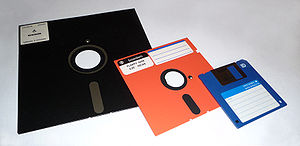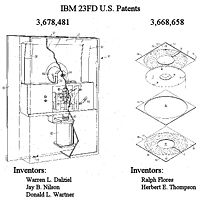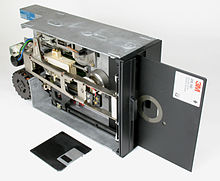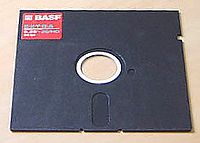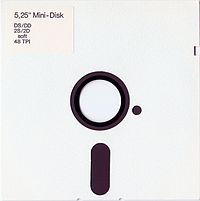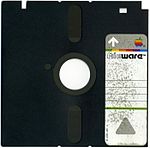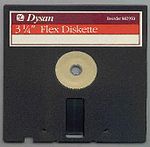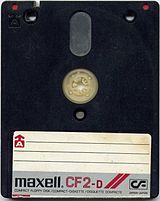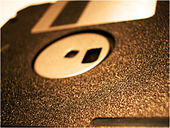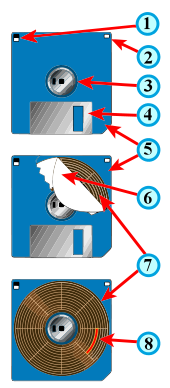- History of the floppy disk
-
Over the history of the floppy disk a number of different formats were used. Floppy disks have now been largely superseded by other storage media and by network file transfer.
Contents
Origins, the 8-inch disk
See also: Table of 8-inch floppy formatsIn 1967, IBM gave their San Jose, California storage development center a task to develop a reliable and inexpensive system for loading microcode into their System/370 mainframes in a process called Initial Control Program Load (ICPL). The System/370 was IBM's first computer system family to make extensive usage of volatile read/write semiconductor memory for microcode[1], so for most models, whenever[2] the power was turned on the microcode had to be loaded (System/370's predecessor, System/360, generally used non-volatile read-only memory for microcode). IBM also wanted inexpensive media that could be sent out to customers with software updates[3].
IBM Direct Access Storage Product Manager Alan Shugart assigned the job to David L. Noble[4], who tried to develop a new-style tape for the purpose, but without success. Noble's team developed a read-only, 8-inch-diameter (200 mm) flexible diskette they called the "memory disk", holding 80 kilobytes of data. The original disk was bare, but dirt became a serious problem so they enclosed it in a plastic envelope lined with fabric that would remove dust particles[5]. IBM introduced the diskette commercially in 1971.[6][7]
The new device, developed under the code name Minnow and shipped as the 23FD, was a standard part of System 370 processing units (IBM internally used another device, code named Mackerel, to write boot disks for distribution to the field[8]). It also was used as a program load device for other IBM products such as the 2835 Storage Control Unit.[9]
Alan Shugart left IBM and moved to Memorex where his team in 1972 shipped Memorex 650, the first read-write floppy disk drive. The 650 had a data capacity of 175 kB, with 50 tracks, 8 sectors per track, and 448 bytes per sector. The Memorex disk was "hard-sectored", that is, it contained 8 sector holes (plus one index hole) at the outer diameter (outside data track 00) to synchronize the beginning of each data sector and the beginning of a track.
In 1973 IBM shipped its first read/write floppy disk drive, the 33FD, as a part of the 3740 Data Entry System,[10] code named "IGAR"[11], designed to directly replace IBM's punched card ("keypunch") data entry machines. A significant feature of IBM's read/write disk media was the use of a teflon-lubricated fabric liner to lengthen media life. In 1976 media supplier Verbatim enhanced resilience further by adding a teflon coating to the magnetic disk itself.[12] The new system used a different recording format that stored up to 250¼ kB on the same disks. Drives supporting this format were offered by a number of manufacturers and soon became common for moving smaller amounts of data. This disk format became known as the Single Sided Single Density or SSSD format. It was designed to hold just as much data as one box of 2000 punch cards.[citation needed] The disk was divided into 77 tracks of 26 sectors, each holding 128 bytes. Note that 77 × 26 = 2002 sectors.
When the first microcomputers were being developed in the 1970s, the 8-inch floppy found a place on them as one of the few "high speed, mass storage" devices that were even remotely affordable to the target market (individuals and small businesses). The first microcomputer operating system, CP/M, originally shipped on 8-inch disks. However, the drives were still expensive, typically costing more than the computer they were attached to in early days, so most machines of the era used cassette tape instead.
Also in 1973, Shugart founded Shugart Associates which went on to become the dominant manufacturer of 8-inch floppy disk drives. Its SA800 became the industry standard for form factor and interface.
In 1976 IBM introduced the 500 KB Double Sided Single Density (DSSD) format, and in 1977 IBM introduced the 1-1.2 MB Double Sided Double Density (DSDD) Format.[13]
Other 8-inch floppy disk formats such as a Burroughs 1 MB unit failed to achieve any market presence.
The 5¼-inch minifloppy
In a 1976 meeting, An Wang of Wang Laboratories informed Shugart Associates' Jim Adkinson and Don Massaro, that the 8-inch format was simply too large for the desktop word processing machines he was developing at the time. Adkinson and Massaro proposed a 5¼-inches wide format which Wang accepted. Shugart Associates then developed a new drive of this size storing 98.5 KB later increased to 110 KB by adding 5 tracks.[14][15] The 5¼-inch drive was considerably less expensive than 8-inch drives from IBM, and soon started appearing on CP/M machines. At one point Shugart was producing 4,000 drives a day. By 1978 there were more than 10 manufacturers producing 5¼-inch floppy drives, in competing physical disk formats: hard-sectored (90 KB) and soft-sectored (110 KB). The 5¼-inch formats quickly displaced the 8-inch for most applications, and the 5¼-inch hard-sectored disk format eventually disappeared.
Apple introduced the 5¼-inch Disk II for the Apple II in 1978, using GCR encoding to store 35 tracks of 13 sectors of 256 bytes (113KB). An upgrade to a more sophisticated GCR scheme in 1980 increased track capacity to 16 sectors (140KB for the disk).
These early drives read only one side of the disk, leading to the popular budget approach of cutting a second write-enable slot and index hole into the carrier envelope and flipping it over (thus, the “flippy disk”) to use the other side for additional storage. This was considered risky by some, for the reason that single sided disks would only be certified by the manufacturer for single sided use. In reality, since some single-head floppy drives had their read/write heads on the bottom and some had them on the top, disk manufacturers routinely certified both sides of disks for use, thus the method was perfectly safe. An alternate reasoning was that when flipped the disk would spin in the opposite direction inside its cover, so some of the dirt that had been collected by the fabric lining in the previous rotations would be picked up by the disk and dragged past the read/write head.[citation needed]
Tandon introduced a double-sided drive in 1978, doubling the capacity, and a new “double density” format increased it again, to 360 KB.[16]
For most of the 1970s and 1980s the floppy drive was the primary storage device for word processors and microcomputers. Since these machines had no hard drive, the OS was usually booted from one floppy disk, which was then removed and replaced by another one containing the application. Some machines using two disk drives (or one dual drive) allowed the user to leave the OS disk in place and simply change the application disks as needed, or to copy data from one floppy to another. In the early 1980s, “quad density” 96-track-per-inch drives appeared, increasing the capacity to 720 KB. RX50[17] was another proprietary format, used by Digital Equipment Corporation's Rainbow-100, DECmate-II and Pro-350. It held 400 KB[18] on a single side by using 96 tracks per inch and cramming 10 sectors per track.
Floppy disks were supported on IBMs PC-DOS and Microsoft's MS-DOS from their beginning on the original IBM PC. With version 1.0 of DOS (1981) only single sided 160 KB floppies were supported. Version 1.1 the next year saw support expand to double-sided, 320 KB disks. Finally in 1983 DOS 2.0 supported 9 sectors per track rather than 8, providing 180 KB on a (formatted) single-sided disk and 360 KB on a double-sided.[19]
In 1984, along with the IBM PC/AT, the high density disk appeared, which used 96 tracks per inch combined with a higher density magnetic media to provide 1,200 KB[20] of storage (formally referred to as 1.2 megabytes). Since the usual (very expensive) hard disk held 10–20 megabytes at the time, this was considered quite spacious. High-density drives could also read and write to double-density disks, allowing an easy upgrade path.
Except for labelling, 5¼-inch high-density disks were externally identical to their double-density counterparts. This led to an odd situation wherein the drive itself was unable to determine the density of the disk inserted except by reading the disk media to determine the format. It was therefore possible to use a high-density drive to format a double-density disk to the higher capacity. This usually appeared to work (sometimes reporting a small number of bad sectors) — at least for a time. The problem was that the high-density format was made possible by the creation of a new high-coercivity oxide coating (after soft-sector formatting became standard, previous increases in density were largely enabled by improvements in head technology; up until that point, the media formulation had essentially remained the same since 1976). In order to format or write to this high-coercivity media, the high-density drive switched its heads into a mode using a stronger magnetic field. When these stronger fields were written onto a double-density disk (having lower coercivity media), the strongly magnetized oxide particles would begin to affect the magnetic charge of adjacent particles. The net effect is that the disk would begin to erase itself. On the other hand, the opposite procedure (attempting to format an HD disk as DD) would fail almost every time, as the high-coercivity media would not retain data written by the low-power DD field. High-density 3½-inch disks avoided this problem by the addition of a hole in the disk cartridge so that the drive could determine the appropriate density.
By the end of the 1980s, the 5¼-inch disks had been superseded by the 3½-inch disks. Though 5¼-inch drives were still available, as were disks, they faded in popularity as the 1990s began. The main community of users was primarily those who still owned '80s legacy machines (PCs running MS-DOS or home computers) that had no 3½-inch drive; the advent of Windows 95 (not even sold in stores in a 5¼-inch version; a coupon had to be obtained and mailed in) and subsequent phaseout of standalone MS-DOS with version 6.22 forced many of them to upgrade their hardware. On most new computers the 5¼-inch drives were optional equipment. By the mid-1990s the drives had virtually disappeared as the 3½-inch disk became the predominant floppy disk.
The "Twiggy" disk
During the development of the Apple Lisa, Apple developed a disk format codenamed Twiggy, and officially known as FileWare. While basically similar to a standard 5¼-inch disk, the Twiggy disk had an additional set of write windows on the top of the disk with the label running down the side. The drive was also present in prototypes of the original Apple Macintosh computer, but was removed in both the Mac and later versions of the Lisa in favor of the 3½-inch floppy disk from Sony. The drives were notoriously unreliable and Apple was criticized for needlessly diverging from industry standards.[21]
The 3-inch compact floppy disk
Throughout the early 1980s the limitations of the 5¼-inch format were starting to become clear. Originally designed to be smaller and more practical than the 8-inch format, the 5¼-inch system was itself too large, and as the quality of the recording media grew, the same amount of data could be placed on a smaller surface. Another problem was that the 5¼-inch disks were simply scaled down versions of the 8-inch disks, which had never really been engineered for ease of use. The thin folded-plastic shell allowed the disk to be easily damaged through bending, and allowed dirt to get onto the disk surface through the opening.
A number of solutions were developed, with drives at 2-inch, 2½-inch, 3-inch and 3½-inch (50, 60, 75 and 90 mm) all being offered by various companies. They all shared a number of advantages over the older format, including a small form factor and a rigid case with a slideable write protect catch. The almost-universal use of the 5¼-inch format made it very difficult for any of these new formats to gain any significant market share. Some of these formats included Dysan and Shugart's 3¼-inch floppy disk, the later ubiquitous Sony 3.5" disk and the 3-inch format:
- the 3-inch BRG MCD-1 developed in 1973 by Marcell Jánosi, a Hungarian inventor of Budapest Radiotechnic Company (Budapesti Rádiótechnikai Gyár - BRG).[22]
- the AmDisk-3 Micro-Floppy-disk cartridge system in December 1982.[23][24], which was originally designed for use with the Apple II Disk II interface card[24]
- the Mitsumi's Quick Disk 3-inch floppies.
The 3-inch floppy drive itself was manufactured by Hitachi, Matsushita and Maxell[25]. Only Teac outside this "network" is known to have produced drives. Similarly, only three manufacturers of media (Maxell, Matsushita and Tatung) are known (sometimes also branded Yamaha, Amsoft, Panasonic, Tandy, Godexco and Dixons), but "no-name" disks with questionable quality have been seen in circulation.
Amstrad included a 3-inch single-sided, double-density (180 KB) drive in their CPC and some models of PCW. The PCW-8512 included a double-sided, quad density (720 KB) as the second drive and later models, such as the PCW-9512 used quad density even for the first drive. The single-sided double density (180 KB) drive was "inherited" by the ZX Spectrum +3 computer after Amstrad bought the rights from Sinclair. The Oric-1 & Atmos systems from Oric International also used the 3-inch floppy drives, originally shipping with the Atmos, but also supported on the older Oric-1.
Since all 3-inch media were double-sided in nature, single-sided drive owners were able to flip the disk over to use the other side. The sides were termed "A" and "B" and were completely independent, but single-sided drive units could only access the upper side at one time.
The disk format itself had no more capacity than the more popular (and cheaper) 5¼-inch floppies. Each side of a double-density disk held 180 KB for a total of 360 KB per disk, and 720 KB for quad-density disks.[26] Unlike 5¼-inch or 3½-inch disks, the 3-inch disks were designed to be reversible and sported two independent write-protect switches. It was also more reliable thanks to its hard casing.
3-inch drives were also used on a number of exotic and obscure CP/M systems such as the Tatung Einstein and occasionally on MSX systems in some regions. Other computers to have used this format are the more unknown Gavilan Mobile Computer and Matsushita's National Mybrain 3000. The Yamaha MDR-1 also used 3-inch drives.
The main problems with this format were the high price, due to the quite elaborate and complex case mechanisms. However, the tip on the weight was when Sony in 1984 convinced Apple Computer to use the 3½-inch drives in the Macintosh 128K model, effectively making the 3½-inch drive a de-facto standard.
Mitsumi's "Quick Disk" 3-inch floppies
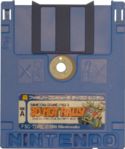 Quick Disk for Nintendo Famicom Disk System
Quick Disk for Nintendo Famicom Disk System
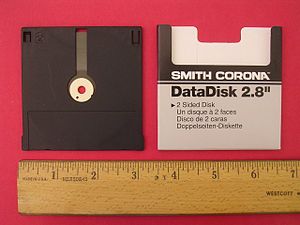 A Smith Corona DataDisk 2.8-inch.
A Smith Corona DataDisk 2.8-inch.
Another 3-inch format was Mitsumi's Quick Disk format. The Quick Disk format is referred to in various size references: 2.8-inch, 3-inch×3-inch and 3-inch×4-inch. Mitsumi offered this as OEM equipment, expecting their VAR customers to customize the packaging for their own particular use; disks thus vary in storage capacity and casing size. The Quick Disk uses a 2.8-inch magnetic media, break-off write-protection tabs (one for each side), and contains a see-through hole near center spindle (used to ensure spindle clamping). Nintendo packaged the 2.8-inch magnetic media in a 3-inch×4-inch housing, while others packaged the same media in a 3 inch×3 inch sq housing.
The Quick Disk's most successful use was in Nintendo's Famicom Disk System. The FDS package of Mitsumi's Quick Disk used a 3-inch×4-inch plastic housing called the "Disk System Card". Most FDS disks did not have cover protection to prevent media contamination, but a later special series of five games did include a protective shutter.[27]
Mitsumi's "3-inch" Quick Disk media were also used in a 3-inch×3-inch housing for many Smith Corona word processors. The Smith Corona disks are confusingly labeled "DataDisk 2.8 inch", presumably referring to the size of the medium inside the hard plastic case.
The Quick Disk was also used in several MIDI keyboards and MIDI samplers of the mid 1980s. A non-inclusive list includes: the Roland S-10[28] and MKS100 samplers, the Korg sqd1, the Korg SQD8[29] MIDI sequencer, Akai's 1985 model MD280 drive for the S-612 MIDI Sampler,[30][31][32] Akai's X7000 / S700 (rack version)[33] and X3700,[34] the Roland S-220,[35][36] and the Yamaha MDF1[37] MIDI disk drive (intended for their DX7/21/100/TX7 synthesizers, RX11/21/21L drum machines, and QX1, QX21 and QX5 MIDI sequencers).
As the cost in the 1980s to add 5.25-inch drives was still quite high, the Mitsumi Quick Disk was competing as a lower cost alternative packaged in several now obscure 8-bit computer systems. Another non-inclusive list of Quick Disk versions: QDM-01,[38] QDD (Quick Disk Drive) on French Thomson micro-computers, in the Casio QD-7 drive,[39] in a peripheral for the Sharp MZ-700 & MZ-800 system,[40] in the DPQ-280 Quickdisk for the Daewoo/Dynadata MSX1 DPC-200,[41][42] in a Dragon machine,[43] in the Crescent Quick Disk 128, 128i and 256 peripherals for the ZX Spectrum,[44] and in the Triton Quick Disk peripheral also for the ZX Spectrum .[44][45]
The World of Spectrum FAQ[46] reveals that the drives did come in different sizes: 128 to 256 kB in Crescent's incarnation, and in the Triton system, with a density of 4410 bits per inch, data transmission rate of 101.6 kbit/s, a 2.8-inch double sided disk type and a capacity of up to 20 sectors per side at 2.5 kB per sector, up to 100 kB per disk. Quick Disk as used in the Famicom Disk System holds 64 kB of data per side, requiring a manual turn-over to access the second side.
Unusually, the Quick Disk utilizes "a continuous linear tracking of the head and thus creates a single spiral track along the disk similar to a record groove."[45] This has led some to compare it more to a "tape-stream" unit than typically what is thought of as a random-access disk drive.[47]
3½-inch format
Sony introduced their own small-format 90.0 mm × 94.0 mm disk, similar to the others but somewhat simpler in construction than the AmDisk 3-inch floppy.[48] The first computer to use this format was Sony's SMC 70[49] of 1982. Other than Hewlett-Packard's HP-150 of 1983 and Sony's MSX computers that year, this format suffered from a similar fate as the other new formats; the 5¼-inch format simply had too much market share.
Things changed dramatically when in 1982 the Microfloppy Industry Committee, a consortium ultimately of 23 media companies, agreed upon a 3½-inch media specification based upon but differing from the original Sony design[50]. The first drives compatible with this new media specification were shipped in early 1983[51]. In 1984 Apple Computer selected the format for their new Macintosh computers.[52] Then, in 1985 Atari adopted it for their new ST line, and Commodore for their new Amiga. By 1988 the 3½-inch was outselling the 5¼-inch[53].
The term "3½-inch" or "3.5 inch" disk was primarily targeted at the non-metric US market and was rounded from the actual metric size of 90 mm used internationally.
The 3½-inch disks had, by way of their rigid case's slide-in-place metal cover, the significant advantage of being much better protected against unintended physical contact with the disk surface than 5¼-inch disks when the disk was handled outside the disk drive. When the disk was inserted, a part inside the drive moved the metal cover aside, giving the drive's read/write heads the necessary access to the magnetic recording surfaces. Adding the slide mechanism resulted in a slight departure from the previous square outline. The irregular, rectangular shape had the additional merit that it made it impossible to insert the disk sideways by mistake as had indeed been possible with earlier formats.
The shutter mechanism was not without its problems, however. On old or roughly treated disks the shutter could bend away from the disk. This made it vulnerable to being ripped off completely (which does not damage the disk itself but does leave it much more vulnerable to dust), or worse, catching inside a drive and possibly either getting stuck inside or damaging the drive.
Evolution
Like the 5¼-inch, the 3½-inch disk underwent an evolution of its own. When Apple introduced the Macintosh in 1984, it used single-sided 3½-inch disk drives with an advertised capacity of 400 kB. The encoding technique used by these drives was known as GCR, or Group Code Recording (similar recording methods were used by Commodore on its 5¼ inch drives and Sirius Computer in its Victor 9000 non PC compatible MS-Dos machine). Somewhat later, PC-compatible machines began using single-sided 3½-inch disks with an advertised capacity of 360 kB (the same as a double-sided 5¼-inch disk), and a different, incompatible recording format called MFM (Modified Frequency Modulation). GCR and MFM drives (and their formatted disks) were incompatible, although the physical disks were the same. In 1986, Apple introduced double-sided, 800 kB disks, still using GCR, and soon after, IBM began using 720 kB double-sided double-density MFM disks in PCs like the IBM PC Convertible and IBM PC compatibles adopted it too, whilst the Amiga used MFM encoding on the same disks to give a capacity of 880 kB.
A newer and better, MFM-based, "high-density" format, displayed as "HD" on the disks themselves and storing 1440 kB of data, was introduced in 1987. These HD disks had an extra hole in the case on the opposite side of the write-protect notch. IBM used this format on their PS/2 series introduced in 1987. Apple started using "HD" in 1988, on the Macintosh IIx, and the HD floppy drive soon became universal on virtually all Macintosh and PC hardware. Apple's FDHD (Floppy Disk High Density) drive was capable of reading and writing both GCR and MFM formatted disks, and thus made it relatively easy to exchange files with PC users. Apple later marketed this drive as the SuperDrive. Interestingly, Apple began using the SuperDrive brand name again in 2001 to denote their all-formats CD/DVD reader/writer.[54]
Besides Sony, Apple was the first major manufacturer to start selling computers with 3½-inch disk drives as well as the first to stop shipping those in 1998 with introduction of iMac.
Another advance in the oxide coatings allowed for a new "extended-density" ("ED") format at 2880 kB introduced on the NeXTcube and NeXTstation in 1991, and on IBM PS/2 model 57 also in 1991, but by the time it was available it was already too small in capacity to be a useful advance over the HD format and never became widely used. The 3½-inch drives sold more than a decade later still use the same 1.44 MB HD format that was standardized in 1989, in ISO 9529-1,2.
References
- ^ The Model 85 of System/360 used a mixture of non-volatile Capacitive Read Only Storage and volatile semiconductor memory; however the latter was mainly used for emulation, microdiagnostics and some low cost features Emerson Pugh et al. (1991). IBM'S 360 and Early 370 Systems. MIT Press. p. 496.
- ^ Except for the 155, 155 II, 165, 165 II and 195.
- ^ Daniel, Eric D.; Mee, C. Denis; Clark, Mark H. (1999). "19. Data Storage On Floppy Disks". Magnetic Recording - The First 100 Years. IEEE Press. p. 302.
- ^ Pugh, Emerson W.; Johnson, Lyle R.; Palmer, John H., "IBM's 360 and Early 370 Systems", Cambridge : MIT Press, 1991. ISBN 0262161230. Cf. pp.513-523 on David L. Noble and the invention of the floppy disk apparatus.
- ^ [1] Oral History Panel on 8 inch Floppy Disk Drives., , Ed. Jim Porter, 2005 - pg 30 "And they finally found out that that was dirt on the disk or a hair or a particle of some sort ... We glued some pink wipe on it, cut the holes in for the head and the center clamping and all of that and we put that on and lo and behold the problem disappeared, clean as a whistle."
- ^ http://www-03.ibm.com/ibm/history/exhibits/storage/storage_chrono20.html
- ^ A Japanese inventor, Yoshiro Nakamatsu, claims to have invented core floppy disk technology, and in 1952 registered a Japanese patent for his invention. He further claims to have later licensed 16 patents to IBM for the creation of the floppy disk. However, there is no evidence independent of Dr Nakamatsu's assertions that supports these claims.
- ^ [2] Oral History Panel on 8 inch Floppy Disk Drives., , Ed. Jim Porter, 2005 - pg 31 "The writer was the Mackerel..."
- ^ IBM Archives: IBM 2305 fixed head storage
- ^ IBM Archives: IBM 3740
- ^ [3] Oral History Panel on 8 inch Floppy Disk Drives., , Ed. Jim Porter, 2005 - pg 9 "IBM did introduce what they called the IGAR, the model 33FD, along with their 3740 data entry system."
- ^ http://www.verbatim-europe.co.uk/en_1/article_40-years-of-verbatim_5154_0.html From garage to global leader in storage.
- ^ http://www.disktrend.com/5decades2.htm Five decades of disk drive industry firsts
- ^ "Porter's Biography". http://www.magneticdiskheritagecenter.org/100th/Progress/Porter/jimporter.htm. Retrieved 2006-07-29.
- ^ "Computer History Museum's Oral History Panel on 5.25 and 3.5 inch Floppy Drives" (PDF). http://archive.computerhistory.org/resources/text/Oral_History/5.25_3.5_Floppy_Drive/5.25_and_3.5_Floppy_Panel.oral_history.2005.102657925.pdf. Retrieved 2007-12-12.
- ^ (48 tpi DSDD) 40 × 2 tracks × 9 blocks/track × 256 × 2 bytes; note that 8 and 10 blocks/track also existed, for 320 KB and 400 KB capacities (see "recovering data from improperly stored floppy disks". http://www.swtpc.com/knowledgebase/kbpage1.htm. Retrieved 2006-05-25.)
- ^ http://home.claranet.nl/users/pb0aia/vax/rx50.html
- ^ 80 × 1 tracks × 10 blocks/track × 512 bytes
- ^ Bozdoc, Marian (2001). "1981 - 1984". MB Solutions. http://mbinfo.mbdesign.net/1981-84.htm. Retrieved 2006-05-25.
- ^ 80 tracks × 2 sides × 15 (512-byte) sectors Table Of Diskette Formats
- ^ AP (June 1, 1991). "Jury Backs Investors in Apple Suit". New York Times. http://query.nytimes.com/gst/fullpage.html?res=9D0CE1D9113EF932A35755C0A967958260. Retrieved 2007-06-16. "A. C. Markkula, an Apple co-founder, and John Vennard, a former vice president, failed to disclose the degree of technical problems Apple had in developing a disk drive that was nicknamed Twiggy" The case was reversed in September 1991.
- ^ "Jánosi Marcell: MCD-1 floppy drive és disk, 1974-1981" (in Hungarian). Octogon. http://www.epiteszethonapja.hu/index.php?pa=index&sess=&lan=0&kat=105&cik=4670. Retrieved 2006-12-28.
- ^ "1981-1983: Business Takes Over". Dan Rice, and Robert Pecot. http://nikkicox.tripod.com/comp1981.htm. Retrieved 2006-06-25.
- ^ a b "Amdek Amdisk I". Tom Owad. http://www.applefritter.com/node/133. Retrieved 2006-06-25.
- ^ "Three-inch floppy disk product announced" (PDF). http://csdl.computer.org/plugins/dl/pdf/mags/mi/1982/02/04070788.pdf. Retrieved 1008-10-04.
A new, compact floppy disk, with dimensions of 80 × 100 × 5 millimeters (about 3 × 4 inches), has been jointly announced by Maxell, Hitachi, and Matsushita. (...) we expect that various disk drives using 3-inch disks will begin to appear in the latter part of 1982. The capacity of the new disk is 125K bytes for the single-sided, single-density version and 500K bytes for the double-sided, double-density version.—Victor Nelson, "New Products," IEEE Micro, vol. 2, no. 2, p. 91, April–June, 1982
- ^ "What file and disk formats are there?". LPS Multilingual. http://www.lpsmultilingual.co.uk/html/02filediskformats.html. Retrieved 2006-06-25.
- ^ "Disk shapes". Atari HQ. http://www.atarihq.com/tsr/fds/disk.html. Retrieved 2006-05-25.
- ^ "ROLAND S-10". Vintage Synth Explorer. http://www.vintagesynth.com/roland/s10.shtml. Retrieved 2006-05-25.
- ^ "KORG SQD-8 INFO". http://www.keyboardmuseum.org/ar/k/korg/s/sqd8.html. Retrieved 2006-05-25.
- ^ "AKAI S-612". Vintage Synth Explorer. http://www.vintagesynth.com/akai/s612.shtml. Retrieved 2006-05-25.
- ^ "434-3403_IMG.JPG" (JPG). Archived from the original on 2006-03-20. http://web.archive.org/web/20060320164456/http://www.autofunk.dk/sale/pics/akai_s612/434-3403_IMG.JPG. Retrieved 2006-05-25.
- ^ "u s e d g e a r s a l e". autofunk.dk. Archived from the original on 2006-05-03. http://web.archive.org/web/20060503194233/http://www.autofunk.dk/sale/gearsale.htm. Retrieved 2006-05-25.
- ^ "AKAI X7000". Vintage Synth Explorer. http://www.vintagesynth.com/akai/x7000.shtml. Retrieved 2006-05-25.
- ^ "AKAI X3700". Vintage Synth Explorer. http://www.vintagesynth.com/akai/x3700.shtml. Retrieved 2006-05-25.
- ^ "ROLAND S-220". Vintage Synth Explorer. http://www.vintagesynth.com/roland/s220.shtml. Retrieved 2006-05-25.
- ^ "Roland S-220". Youngmonkey.ca. http://www.youngmonkey.ca/background/museum/music_equipment/commercial/Roland-S220.html. Retrieved 2006-05-25.
- ^ "MDF1". Synthony's Synth & Midi Museum. http://www.synthony.com/vintage/MDF1.html. Retrieved 2006-05-25.
- ^ "MSX Hardware List - Pictures for Mitsumi QDM-01 quickdisk-drive". http://www.hardwarelist.msxnet.org/product_pictures.php?s=1nfr&h=aaagak&agb=N&agc=N&agd=D&aga=B&manufid=75&aka=A&akb=A&akc=N&akd=N&ake=A&productid=316. Retrieved 2006-05-25.
- ^ "Casio (Japan)". The Ultimate MSX FAQ - MSX Hardwarelist section. http://www.faq.msxnet.org/hardware.html#Casio. Retrieved 2006-05-25.
- ^ "THE OTHER INTERESTING 8-BIT COMPUTERS". Geocities.com. Archived from the original on 2006-09-02. http://web.archive.org/web/20060902024827/http://www.geocities.com/SiliconValley/9723/other.html. Retrieved 2006-05-25.
- ^ "Computerverzameling M". http://members.chello.nl/mlampers/Homecomputers.htm. Retrieved 2006-05-25.
- ^ "Companies who once produced some kind of MSX hardware". http://msx.gnu-linux.net/hardware.html. Retrieved 2006-05-25.
- ^ "History of the Dragon Computer". http://www.fortunecity.com/skyscraper/disk/162/draghist.html. Retrieved 2006-05-25.
- ^ a b "Disk Reference". comp.sys.sinclair FAQ. http://www.worldofspectrum.org/faq/reference/diskreference.htm. Retrieved 2006-05-25.
- ^ a b "Hardware Feature #20 - Triton QD". http://www.worldofspectrum.org/hardware/feat20.html. Retrieved 2006-05-25.
- ^ "World of Spectrum - The WoS FAQ". http://www.worldofspectrum.org/WoSFAQ.html. Retrieved 2006-05-25.
- ^ "MSX1 section". The Ultimate MSX FAQ. http://www.faq.msxnet.org/msx1.html. Retrieved 2006-05-25.
- ^ SONY Micro Floppydisk Drive - Model OA-D30V
- ^ Sony SMC70
- ^ "The Microfloppy—One Key to Portability," Thomas R. Jarrett, Computer Technology Review, Winter 1983 (Jan 1984), pp 245-7
- ^ 1983 Disk/Trend Reports, Flexible Disk Drives
- ^ Quick, Hide In This Closet! Steve forbid us to work with Sony
- ^ 1991 Disk/Trend Report, Flexible Disk Drives, Figure 2
- ^ Apple Ships Industry’s First SuperDrive
Patents
- Flores, et al., "Magnetic Record Disk Cover", US Patent 3,668,658 applied for December 22, 1969 and granted June 6, 1972 assigned to IBM.
- Dalziel , et al., "Data Storage Apparatus Employing a Single Magnetic Disk", US Patent 3,678,481, applied for March 13, 1970, and granted July 18, 1972, assigned to IBM.
Categories:- History of computing
- Computer storage media
- Floppy disk drives
- Legacy hardware
Wikimedia Foundation. 2010.

